Controversial Arctic Cruise
Air Date: Week of April 15, 2016
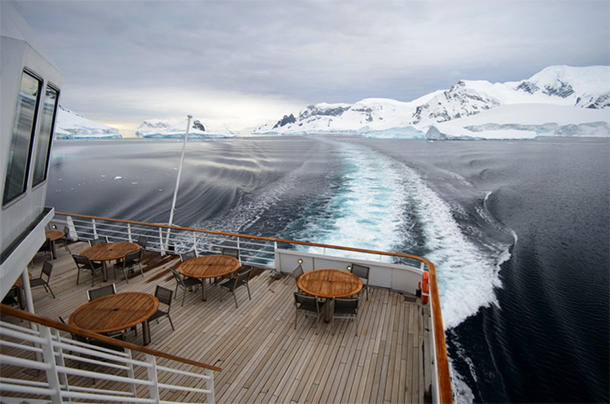
Crystal Cruises’ new luxury vessel will embark on a trip through the Bering Strait and Northwest passage in a trip that begins in Alaska and docks in New York City 32 days later. (Photo: Reeve Joliffe Flickr CC BY-NC-ND 2.0)
Thanks to global warming, a 1000-passenger luxury cruise liner will travel through the fabled Northwest Passage in the Arctic for the first time this summer. Canadian legal scholar Michael Byers was invited to come along as a lecturer, but he declined because he is so concerned about climate change. He tells host Steve Curwood that tourism in the Arctic is dangerous and too much ecotourism could threaten the ecosystem and the people who live there.
Transcript
CURWOOD: The loss of sea ice in the high north is also changing the economic life of the planet with new shipping lanes, chances for oil exploration, and tourism. This fall Crystal Cruises will run a 1,000 passenger cruise ship on what they’re calling the Northwest Passage expedition through the Arctic Ocean. Joining us to discuss the trip and the prospects for Arctic tourism more generally is Michael Byers, the Canada Research Chair in Global Politics and International Law at the University of British Columbia. Welcome to Living on Earth.
BYERS: It's good to be here. Thank you.
CURWOOD: Hey, tell us a little bit please about this cruise. What kind of a ship are we talking about and what's the route?
BYERS: Well, we're talking about the world's most luxurious cruise ship. The Crystal Serenity is going to sail from Anchorage, Alaska, to New York City around the northern coast of North America through the fabled northwest passage, through the 19,000 islands that constitute Canada's high Arctic. The voyage will take a month and it will cost each passenger between $25,000 US dollars all the way up to $120,000 for one of the top suites. It's going to be quite a trip.
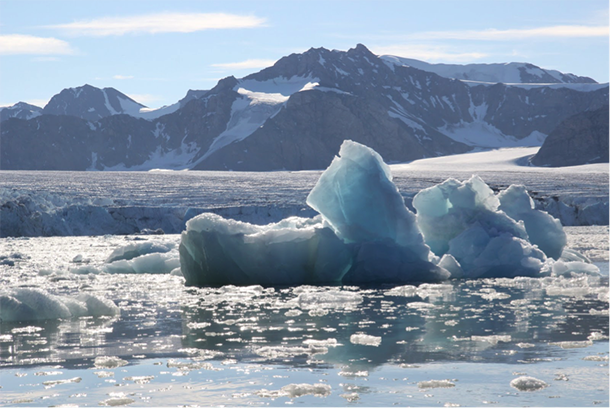
Trade and tourism in the Arctic have become a point of interest in recent decades as portions of the region that were previously frozen have begun to melt. (Photo: Gary Bembridge, Flickr CC BY 2.0)
CURWOOD: Yeah, and how unprecedented is? I mean how many ships have done this route before?
BYERS: Well, no cruise ship the size has done the route before. There have for a number of years been smaller so-called expedition cruise ships that carry 100 or 150 passengers. There have been a few large cargo ships that have made the voyage, and of course, Coast Guard icebreakers from Canada and the US have done so, as well increasingly as so-called adventurers in private yachts upwards of 25 or 30 a year, but no cruise ship of this size. These 1,000 passengers have very large cabins, they're being cared for by 650 crewmembers. They're even bringing a support ship along that has its own helicopter, so it's a major enterprise and I was in fact invited to go on board the Crystal Serenity as a lecturer and after considerable thought, two months ago turned the trip down.
CURWOOD: Why? Why did you say no? It sounds like a great trip.
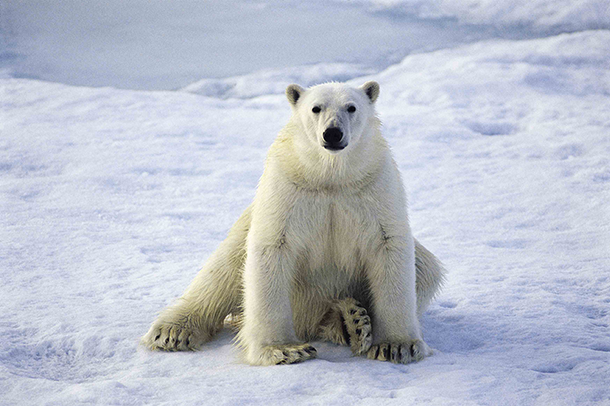
A voyage through the Northwest Passage could offer a chance to see threatened species like the polar bear (Photo: LWP Kommunikáció, Flickr CC BY 2.0)
BYERS: Well, a couple of reasons, the most significant being I've become increasing concerned about climate change and to be entirely open I've done the trip before on Canadian Coast Guard ice breakers, and on one occassion on one of these smaller expedition cruise ships, and I thought about whether I needed to be part of this trip. First of all because the ship has a pretty large carbon footprint so it's contributing to climate change by going to the Arctic and also the fact that this trip is a form of so-called extinction tourism. The only reason that the passengers can go to the Arctic is because the Arctic is on the edge of a precipice, the sea ice is melting and the ecosystem is being overturned. It's a little bit like going to see an endangered species on the savannah of Africa or the Galapagos Islands because you don't think it will be there in five or 10 years and I again found that a bit perverse and decided I could not personally go. Now, I'm not criticizing those people who choose to go. Again, I've been...I've already seen it. I don't need convincing about the reality of climate change.
CURWOOD: I'm also wondering about the impact of such a tour ship. I mean, you go to place like Nome, Alaska, and you know how big Nome is. It's not exactly...I mean a snowball maybe you could throw from one end of downtown to the other almost. How can Nome handle 1,000 people disembarking there?
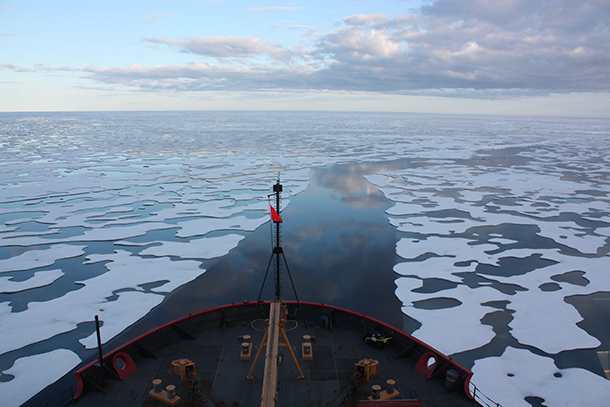
A US Coast Guard ice breaker in the Beaufort Sea (Photo: NASA, CC BY 2.0)
BYERS: Well, that's a question for the residents of Nome, Alaska, and also for the three small aboriginal communities in Canada's high Arctic where the ship will stop. And certainly the cultural impact could be severe, the environmental impact on the local wildlife could be significant. But that's a decision that the residents need to make. There’s a more problematic issue in terms of the impact on the marine ecosystem as this large ship passes through. For instance, there are many whales in the Arctic - Bowhead whales, Beluga whales, Narwhal - and these whales are highly sensitive to noise because they communicate using sound and if you have large ships passing through this can disrupt the whales while they're calving, while they're mating, and so that's a concern. There's also a potential risk of an oil spill, and I don't want to overstate it with regards to the Crystal Serenity because the Crystal Serenity is very well-managed. But any large ship will have hundreds of thousands of gallons of fuel oil on board and oil in cold water degrades very slowly. So if you remember the Exxon Valdez and you transfer that situation to the high Arctic you have a situation that's even worse.
CURWOOD: Well, I'm also wondering about basic safety for those thousand passengers. If something goes wrong - I know Crystal cruises as you say it is very well run, but it's a human invention so things can go wrong. How the heck do you get 1,000 people out of the high Arctic if there's a problem?
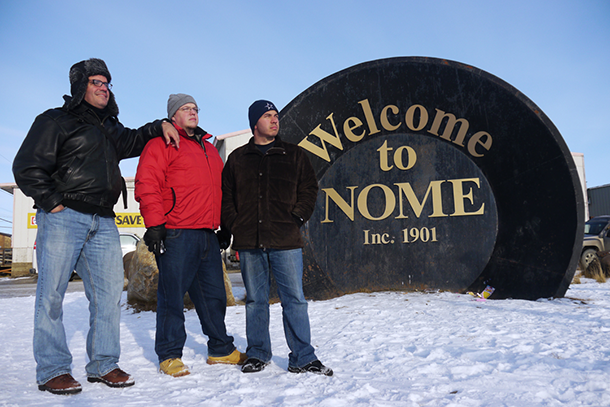
The cruise ship will stop in Nome, Alaska and several indigenous towns (Photo: Dan Perez, Flickr CC BY-NC 2.0)
BYERS: Well, you might not be able to do so, and even though the ship is passing through the Arctic during the late summer, I have sailed the same waters in the summertime in 20 foot waves, in gale force winds. So, there are risks and search and rescue capacities in the Arctic are very stretched. Canada bases its search and rescue helicopters in southern Canada on the west coast and on the east coast, it can take them up to two days to get to the northwest passage, so we're talking about very poor search and rescue coverage and real dangers from shallow uncharted waters, from the increased existence of icebergs in these waters. This is actually one of the ironies of climate change. Although the sea ice that forms on the surface of the water in the winter, although that is diminishing, the number of icebergs is actually increasing as climate change melts the surface of land-based glaciers, and that meltwater lubricates the motion of the glaciers into the sea and small chunks of icebergs called growlers are very, very hard to see because they're very dense, they floating on the water and they can punch a hole in the hull of a cruise ship. In fact, a decade ago a small expedition cruise ship sank in Antarctica after striking a growler, and if the Crystal Serenity were to have that kind of accident happen in the Canadian Arctic, well, quite frankly, I would not want to be on board.
CURWOOD: You are perhaps alluding to the first passage of a major large super-large ship more than a century ago. Sounds like this could end up like the Titanic?
BYERS: Well I don't want to exaggerate the risk. Again Crystal Cruises is a very good company. Passengers pay an awful lot of money to have the highest standards of safety so this ship will probably be OK. My biggest concern about cruise ship safety actually involves the other ships that will follow in subsequent years. Crystal is going to open this door and Holland America and Disney and Costa are
all going to come through in the future because it's a place that people want to visit, that they want to see, and all of your listeners will remember the Costa Concordia which crashed onto the rocks along the coast of Italy a few years ago. The Canadian Arctic, the north coast of Alaska is infinitely more dangerous than the coast of Italy.
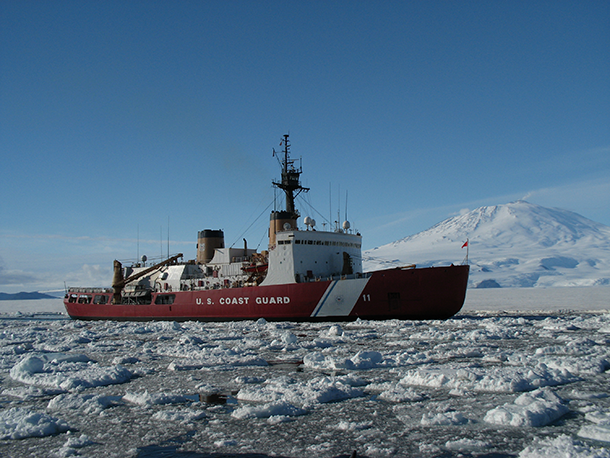
One of the concerns with the trip is that rescue would be very difficult in the high Arctic if an accident were to occur (Photo: Lin Padgham, Flickr CC BY 2.0)
CURWOOD: So you say that we're likely to, after this voyage, we'll see many many more. How should this industry be regulated?
BYERS: The first thing is that people should be making informed choices as to where they go on vacation. I personally think that if we're concerned about climate change perhaps we should fly less, perhaps we should stay closer to home. In terms of what governments could do is to make sure that the strictest safety standards apply to these voyages. So to give you just one simple example: ships that are sailing within the coastal waters of the United States and Canada on the Pacific or the Atlantic coasts are required to use low-sulfur fuel to reduce the amount of air pollution. That's not the case in the American or Canadian Arctic and this is a real problem because that high-sulfur fuel produces a lot more particulates which when they land on ice or snow darken the surface, absorbs more solar energy, and accelerate the melting process. Now, coming back to the Crystal Serenity, again, Crystal is a good company. They are voluntarily using low-sulfur fuel for this voyage, but the ships that follow might not do so, and the US and Canadian governments are not requiring that they do so.
CURWOOD: Michael, by the way you wrote a book called "Who owns the Arctic?" So tell me, who controls this territory and what laws would apply to companies who are trying to do business in the high Arctic?

Michael Byers is a the Canadian Research Chair in Global Politics and international law at the University of British Columbia and author of the book, “Who Owns The Arctic?” (Photo: courtesy of Michael Byers)
BYERS: Well, Canada and the United States dispute the legal status of the northwest passage. United States says that, “yes it's Canadian waters but there's almost an easement through Canadian waters that enables foreign ships to enter with very little restriction.” Canada objects to that, says, “no, this is a situation of internal waters were the full force of Canadian law applies.” One of the things that the voyage of the Crystal Serenity should be saying to politicians in Washington and Ottawa is that the northwest passage is now opening, we can't afford to have a diplomatic dispute between these two countries. I've been making this pitch for a long time and governments don't listen to me, but the whole point is the Arctic is opening. Climate change is real. These waters are becoming busy and governments need to get their act together to protect the environment while we still can.
CURWOOD: Michael Byers is the Canada research chair in global politics and international law at the University of British Columbia. Thanks so much for taking the time.
BYERS: It's been a great pleasure. Thank you.
Links
“Who Owns the Arctic?” by Michael Byers
Read Susanne Goldenberg’s op-ed in the Guardian about Arctic tourism
Living on Earth wants to hear from you!
Living on Earth
62 Calef Highway, Suite 212
Lee, NH 03861
Telephone: 617-287-4121
E-mail: comments@loe.org
Newsletter [Click here]
Donate to Living on Earth!
Living on Earth is an independent media program and relies entirely on contributions from listeners and institutions supporting public service. Please donate now to preserve an independent environmental voice.
NewsletterLiving on Earth offers a weekly delivery of the show's rundown to your mailbox. Sign up for our newsletter today!
 Sailors For The Sea: Be the change you want to sea.
Sailors For The Sea: Be the change you want to sea.
 The Grantham Foundation for the Protection of the Environment: Committed to protecting and improving the health of the global environment.
The Grantham Foundation for the Protection of the Environment: Committed to protecting and improving the health of the global environment.
 Contribute to Living on Earth and receive, as our gift to you, an archival print of one of Mark Seth Lender's extraordinary wildlife photographs. Follow the link to see Mark's current collection of photographs.
Contribute to Living on Earth and receive, as our gift to you, an archival print of one of Mark Seth Lender's extraordinary wildlife photographs. Follow the link to see Mark's current collection of photographs.
 Buy a signed copy of Mark Seth Lender's book Smeagull the Seagull & support Living on Earth
Buy a signed copy of Mark Seth Lender's book Smeagull the Seagull & support Living on Earth

